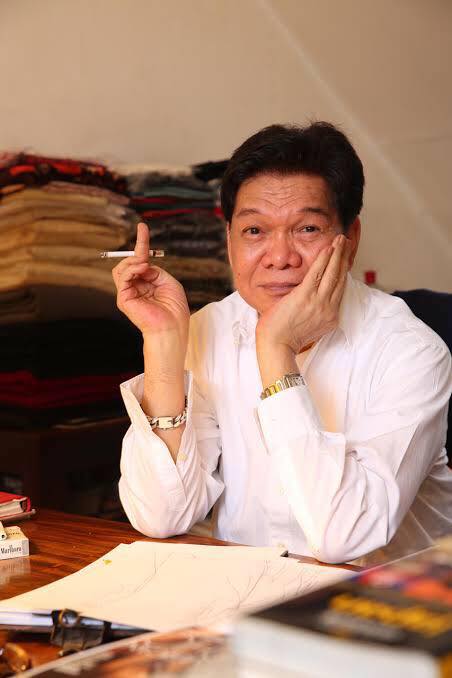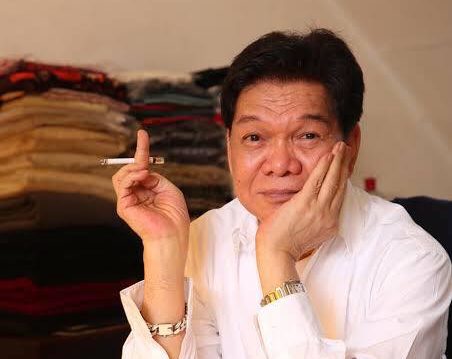
Though known as President Corazon Aquino’s designer, Auggie Cordero’s influence encompassed more. At the forefront of a progressive Philippine fashion scene, he created clothes that expressed the freedom and the verve of the ’70s and ’80s. Cordero, who died on Oct. 21, made high fashion and Hollywood glamour effortlessly accessible to young women.
“Fashion forecasting comes from within,” said designer/entrepreneur and family friend Rina Go. “It is instinctive, but also informed by a multitude of facets—among them Hollywood, the local celebrity scene and current events. It is what moves you to create, with the end view of being recognized as an industry mover. How does this happen? Your collection spurs an avid following—women (or men) confidently sporting looks that you dreamed up. That was Auggie, whose creations made the meaning of ‘fashionable’ or ‘au courant’ crystal clear.”
Baggy pants, cabbage roses
Gifted with the flair for illustration, Cordero worked behind the scenes for modiste Emma Crisologo in the 1960s. He sketched what he described as “tailored day dresses” for the customers while learning the intricacies of dressmaking.
Preferring to be his own boss, he put up his first namesake atelier on Herran (now Pedro Gil), which was financed by a family member in 1970. Designer Oskar Peralta shortened his name from Augusto to “Auggie” which, Peralta said, sounded more appealing. Since the shop was near exclusive schools, girls and their mothers flocked to Cordero for proms, parties and debuts.
Peralta noted that unlike his other gay friends, Cordero was prudent and organized.
“Wala siyang kalokohan (He didn’t fool around),” he said. Everybody knew that Cordero was introverted, preferring to immerse himself in his collection of movies and books.
Society doyenne Chito Madrigal-Collantes, then social directress of Hyatt Manila, featured him with other upcoming designers in the hotel’s groundbreaking fashion shows.
“The Hilton had the mature designers—Bayani Casimiro, Aureo Alonzo, et al. Hyatt catered to the youthquakers. Auggie was among the top young designers,” said former designer Lorenzo Leviste, who assisted Cordero.An avid reader, Cordero was influenced by Yves Saint Laurent who, in the ’70s, was inspired by Gabrielle “Coco” Chanel’s streamlined silhouettes of the 1920s. Cordero adapted YSL’s look of that era. Dubbed “The Great Gatsby” look, pleat-front baggy pants with cuffs, most notably the wide waist band cinched by a narrow belt and the H-line dress, became the rage in Manila. He accessorized with the huge cabbage rose and a knee-length pearl necklace.
Swirl skirts
Then again, Cordero got girls excited with his swirl skirt, panels of diagonal-cut fabric in contrasting colors and patterns that twirled in movement. “In one month, the seamstresses must have done 50 swirl skirts,” recalled Leviste.
In the early years of martial law, first lady Imelda Marcos initiated “Bagong Anyo,” a series of fashion shows promoting contemporary Filipiniana and local weaves, Cordero modernized the balintawak (the terno with a sash and apron) and the camisa de chino. The kimona was done in gingham and eyelet cotton, which became a hit, cited Leviste.
Cordero later tweaked the barong Tagalog for women by folding the sleeves and tucking them in loose pants or his signature dirndl and shirred skirts made of local weaves, said longtime friend, fashion illustrator/designer Loretto Popioco.
He then came out with his versions of the Peasant Look, the Safari Look, the pantsuit and the big bows, all inspired by Saint Laurent.
Some of his signature looks were derived from movies. “Auggie was a fan of Audrey Hepburn. He created his own versions of the little black dress, made famous by ‘Breakfast At Tiffany’s.’ He had his own stamp of quiet luxury and class, similar to how he defined his style and lived his life,” said Ben Chan, CEO of lifestyle company Suyen Corp.
From “Annie Hall,” the 1977 movie that popularized Diane Keaton’s mannish style, he got many girls wearing neckties or bowties and vests.
Dressing up Cory
Cordero was also influenced by Roy Halston’s unstructured and spare designs in his exploration of denims and linens.
He shot to prominence when he dressed up President Cory’s casuals with yellow linen dresses with lace collars and piña formals, recalled Popioco.
“A designer fits the character onto the clothes. Cory was conservative but needed a polished look. It was very Chanel,” said Go.
Aquino famously chucked the terno for unfussy Filipiniana. “Auggie made this embroidered jusi kimona worn over a patadyong with checkered lining. The bright colors of the lining were diffused by the jusi,” said Leviste
Throughout the ‘90s, Cordero’s trademarks became apparent in fashion shows. “Expect linens, chambray, organza, taffeta, padded shoulders, pant suits and spare jackets.” said Leviste.
“French Chantilly lace and duchess satin were some of his favorites,” said Go.
“He embellished with lace, frills, dots, pearls and brooches,” said Popioco.
Cordero also launched modeling careers. He liked exotic types such as Menchu Menchaca, Anna Bayle (who became Asia’s first supermodel), Joyce Oreña and Georgette Nepomuceno, and fair beauties like Gina Leviste and Wanda Louwallien. When he saw Susan Reyes and Louwallien in commercials, he immediately sought them out.
Cordero gave Louwallien her first break in fashion directing in the ‘70s. He discovered Margie Moran, then a high school student, whom he recruited to join the Hyatt fashion shows. Likewise, he designed her wardrobe for the Miss Universe 1973 in Athens, where she won the title.
Intensely private
Leviste said Cordero was painfully shy that it was often misconstrued as aloofness. “At his shop, he treated everybody equally,” he said. Back home, he retreated to his books and movies.
Other longtime friends pointed out that Cordero was selective of his company. However, people close to him said he was fun. “Over sumptuous home-cooked food, conversations were deep, laughter was abundant, and life-long friendships were made,” said Chan.
One of his most enduring friendships was with former Lifestyle editor Thelma San Juan, whom he met in the early ‘70s. In her days with Times Journal and Chronicle, he opened her eyes to go beyond general features and become knowledgeable in various topics. He made her read fashion books and shared conversations with her that informed her reportage of fashion shows and helped her to reconceptualize Metro magazine under ABS-CBN Publishing.
“He was the original Google,” San Juan said.
She considered Cordero as part of the family. When San Juan’s mother died, the editor learned that Cordero had prepared a Maria Clara as an elegant send-off when the elderly lady was in a coma.
For his own send-off, the intensely private Cordero didn’t want any fuss. He died last Oct. 21 at age 78 of acute pneumonia and sepsis shock at Makati Medical Center. His wake was limited to relatives and family friends.
“Other designers should understand that his wake could never be a party because he was never a party animal. He didn’t have a life outside of his room and shop,” explained said San Juan.
Etched in Chan’s mind is Cordero as the ultimate aesthete: “I will always picture Auggie, just like a scene from cinema: surrounded by his books with cigarette in hand, his silhouette set against the light from his favorite film.”









































